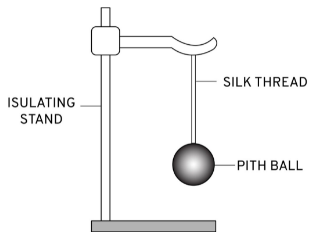
Describe a pith ball electroscope. How can you use it to test whether a body is charged or uncharged ?
Answer
420.9k+ views
1 likes
Hint: A pith ball is a little ball of pith hanging on a thread that indicates the existence and strength of electric charge in an object close or contacting it, according to the definition. Because pith is a light, non-conductive substance, it was chosen.
Complete answer:
A pith ball electroscope is a gadget that detects whether or not a body is charged. A pith ball is hung in mid-air by a thread. On the basis of charges, when a charge body is introduced near the ball, it will either attract or repel the ball, as like charges repel and unlike charges attract. Any charging method can be used to charge the pith ball.

When you contact the pith ball to a charged object, some of the charges on the charged object's surface migrate to the surface of the ball. The ball may then be used to discern the polarity of charge on other objects since it will reject charges of the same polarity or sign as it, but will attract charges of the opposite polarity.
By using a positively charged pith ball electroscope, we will be able to determine whether the charge on a charged body is positive or negative. Bring the charged body as close to the pith ball as possible (without touching it). The body has a similar charge (positive charge) if the pith ball goes away from it, and a negative charge if the pith ball goes towards it.
Note: A gold-leaf electroscope is another form of traditional electroscope that is used to measure the amount of electric charge in a body. The concept of charge repulsion between like signs underpins their operation. When leaves that are electrically linked become electrically charged, they push apart.
Complete answer:
A pith ball electroscope is a gadget that detects whether or not a body is charged. A pith ball is hung in mid-air by a thread. On the basis of charges, when a charge body is introduced near the ball, it will either attract or repel the ball, as like charges repel and unlike charges attract. Any charging method can be used to charge the pith ball.

When you contact the pith ball to a charged object, some of the charges on the charged object's surface migrate to the surface of the ball. The ball may then be used to discern the polarity of charge on other objects since it will reject charges of the same polarity or sign as it, but will attract charges of the opposite polarity.
By using a positively charged pith ball electroscope, we will be able to determine whether the charge on a charged body is positive or negative. Bring the charged body as close to the pith ball as possible (without touching it). The body has a similar charge (positive charge) if the pith ball goes away from it, and a negative charge if the pith ball goes towards it.
Note: A gold-leaf electroscope is another form of traditional electroscope that is used to measure the amount of electric charge in a body. The concept of charge repulsion between like signs underpins their operation. When leaves that are electrically linked become electrically charged, they push apart.
Recently Updated Pages
Master Class 12 Business Studies: Engaging Questions & Answers for Success

Master Class 12 English: Engaging Questions & Answers for Success

Master Class 12 Social Science: Engaging Questions & Answers for Success

Master Class 12 Chemistry: Engaging Questions & Answers for Success

Class 12 Question and Answer - Your Ultimate Solutions Guide

Master Class 12 Economics: Engaging Questions & Answers for Success

Trending doubts
Give 10 examples of unisexual and bisexual flowers

Draw a labelled sketch of the human eye class 12 physics CBSE

Differentiate between homogeneous and heterogeneous class 12 chemistry CBSE

Write a short note on Franklands reaction class 12 chemistry CBSE

Differentiate between insitu conservation and exsitu class 12 biology CBSE

What are the major means of transport Explain each class 12 social science CBSE




